No Results Found
The page you requested could not be found. Try refining your search, or use the navigation above to locate the post.

In the realm of nonprofit organizations where every dollar donated is a potential lifeline for a cause, the expertise of nonprofit consultants can shine like a guiding star. Their goal is to work behind the scenes using their knowledge and experience to help nonprofits thrive, grow, and make a meaningful impact on the world.
In this article, we will introduce you to some of the brightest minds in the nonprofit consultancy sphere. These 10 nonprofit consultants are experts in their respective fields with a priority empowering organizations.
Notice their unique approaches and deep insights that have helped many nonprofits by enabling them to reach new heights.
Meet the strategist extraordinaire who can turn a vague vision into a concrete roadmap for success. With a penchant for dissecting complex challenges and crafting innovative solutions, this consultant has helped nonprofits refine their mission, set clear objectives, and navigate the treacherous waters of the nonprofit landscape.
Our recommendation:
What makes this nonprofit strategic planning consultant unique?
Yes, we were brave enough to put ourselves on this list. Catapult brings a wholistic, innovative approach to strategic planning using their 6A Planning Process that often results in nonprofits having 10X impact without having to dramatically increase their annual revenue. You can find out more here.
In today’s digital age where everyone has the internet in the palm of their hand, utilizing Google’s Ad Grant program is an essential for every nonprofit (they give away $10K a month for nonprofits to spend on Google Ads). This consultant can help nonprofits find new donors, volunteers, advocates, and beneficiaries by choosing high-quality keywords and suggesting digital marketing strategies around those keywords.
Our recommendation:
What makes this nonprofit Ad Grant consultant unique?
They have a flat rate they charge per month, run everything soup to nuts, are highly effective at targeting and make the grant writing and approval process through Google frictionless.
Navigating the complexities of the nonprofit sector can be a daunting task when it comes to executive compensation, pay bands and benefits. This consultant serves as a compass to all things HR related, ensuring that employee compensation operates within the bounds of the law while maximizing what is possible.
Our recommendation:
What makes this nonprofit HR consultant unique?
They specialize in HR and have chosen to go deep rather than wide with an impressive list of former clients who have utilized their HR services.
No one can weave a tale quite like someone gifted at writing stories, messaging and compelling copy. With the power of storytelling, they have the ability to connect audiences emotionally to a cause that sparks a desire to support and get involved. Their expertise in crafting compelling narratives has helped nonprofits create a stronger bond with their supporters.
Our recommendation:
What makes this messaging consultant unique?
Messaging can be an arduous process that feels like pulling teeth. Carone Designs is unique because it is in the bottom third of cost, works with short and crisp timelines, and uses messaging that is always pushing people towards their next step.
A nonprofit’s board is its guiding force and one of the places where nonprofit leadership can quickly go awry. Their expertise in board development and governance helps nonprofits steer toward their missions with precision and unity.
Our recommendation:
Nonprofit Board Governance Consultants
What makes this board development consultant unique?
This consultancy specializes in Board Governance and has a genuine passion for healthy, engaged boards. They are a one stop shop for governance: selection, onboarding, training, work subteams, board culture, etc.
Measuring impact is not just about numbers – it is about telling the story of the change created. This consultant excels in designing robust evaluation frameworks that demonstrate the real-world effects of nonprofit work by providing valuable insights for donors and stakeholders.
Our recommendation:
What makes this reporting consultant unique?
This organization only does one thing and they do it very, very well: Impact reporting. Working primarily with faith based nonprofits, they know how to – 1) Connect data to meaning and mission 2) Make it affordable for any and all size organizations 3) Lead your organization through a simple process that generates your report quickly and beautifully.
In a world where inclusivity is paramount, this consultant specializes in guiding nonprofits on their journey toward diversity, equity, and inclusion. They provide vital guidance on policies, practices, and culture that foster a more equitable and welcoming environment.
Our recommendation:
What makes this D&I consultant unique?
LaPiana has over 25 years of award winning consulting experience and is one of the early pioneers in thinking about diversity and inclusion with nonprofit organizations. They have worked with some of the largest and most respected organizations and have a long history of D&I culture change.
Being able to find talent who turn into extraordinary employees at nonprofits is like finding Leonard Bernstein – What you need is a Maestro. Their knack for creating profiles, screening and filtering candidates, and walking nonprofits through a process of interviewing and hiring will literally lead to a significant amount of money saved.
Our recommendation:
What makes this grant writing consultant unique?
What makes Slingshot unique is a speciality in faith based nonprofits, a process that feels honoring and relational for both the employee and the candidate, and a very high success rate with C-Suite level leaders.
In the nonprofit world, money is the lifeblood of impact, and this consultant knows how to make it flow. Their mastery of fundraising techniques, from traditional campaigns to cutting-edge digital strategies, adapting techniques for generational shifts, has enabled nonprofits to secure the resources they need to drive change.
Our recommendation:
What makes this fundraising consultant unique?
This organization specializes in strategic planning and fundraising, with an explicit value around creating new playbooks. Catapult is unique in fundraising strategy as it combines 1) A money-back guarantee, 2) More than $800M raised, 3) A way-too-affordable Custom Fundraising playbook. You can check out their fundraising services here.
A strong visual brand for a nonprofit fosters trust in an organization, telling volunteers, potential employees, people you are serving and donors who are staying true to your mission and remaining focused. Consistent branding can help build community and excitement about a nonprofit.
Our recommendation:
What makes this nonprofit strategic planning consultant unique?
Historic provides a for-profit Branding Agency service for medium-range pricing. They have made their name on visual branding and identity while using a process that customers enjoy.
These 10 nonprofit consultants represent a diverse and dynamic force for good in the world. Each one possesses unique talents and expertise and they all share a common goal: to empower nonprofits to make a lasting impact on the causes they hold dear. As we highlight their contributions, there are other consultants serving nonprofits well. The 10 Best Nonprofit Consultants + How to Choose The One That Is Right For You
Catapult’s published The Ultimate Strategic Planning Black Book to help nonprofits like yours take the first steps towards developing a rock-solid strategic plan. Join our email list to get the guide now.
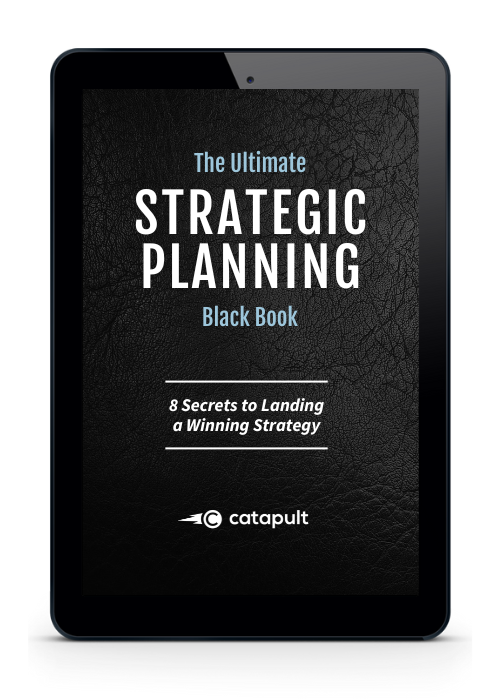
The page you requested could not be found. Try refining your search, or use the navigation above to locate the post.

In most successful nonprofits, the board requires a refreshed strategic plan every 3-5 years and this can feel like drudgery. But in reality, this is one of the most important ways a CEO or Executive Director can win in their role.
For the sake of this article, we would like to draw on a metaphor: in the world of nonprofits, strategic planning is like an epic odyssey that shapes an organization’s future.
As the captain of your nonprofit ship, it is your responsibility to guide your board through this exhilarating journey. So, giving ourselves over to the metaphor, …grab your compass and don your captain’s hat as we set sail on a strategic planning adventure filled with twists, turns, and unexpected discoveries as you lead your board through this process..
Imagine your board as a crew of intrepid explorers ready to embark on a grand adventure. First things first: assemble a diverse team with a mix of skills, perspectives, and personalities. Just like any epic quest, having a well-rounded ensemble of characters will make your strategic planning voyage more colorful and dynamic. Not everyone on the team will be board members but it is important to have a strong board presence for buy-in.
Every voyage needs a map and strategic planning is no different. As the captain, it is your role to help chart the course. Start by setting clear goals and objectives. Picture them as distant shores you aim to reach. With a destination in mind, your board will have a purpose around which to unite. You will also want to instill confidence in the process. That is often why nonprofit captains select a consultant to help them plot the course and guide the strategic planning process.
In any voyage there may be anchors weighing you down. These can be old ideas, outdated strategies, or resistance to change. As the captain, it is your job to hoist those anchors and set your ship free. If you have chosen well, your strategic planning consultant will see these obstacles far in advance and guide you through those choppy waves. You will want to encourage your board to let go of the past and embrace new possibilities by using “emotional touchstones” and “this is that” moments as you go. After all, it is hard to sail into the future when you are anchored to the past.
Every adventure has its storms and strategic planning is no different. Expect disagreements, conflicting opinions, and rough waters along the way. As the captain, your job is to steer the ship through these challenges, keeping everyone on board and focused on the destination. Use active listening, pre-meetings and co-creative processes to calm the seas.
The strategic planning process always takes longer than you think. On a long journey, morale is critical. Keep your board motivated and engaged by celebrating small wins, acknowledging their efforts, and reminding them of the bigger picture. Why does this journey matter? Recognizing how their contributions are helping the long-term mission will keep spirits high even during the toughest parts of the voyage.
Just like in a thrilling adventure, you may stumble upon unexpected treasures during your strategic planning journey. New opportunities will emerge along the way that you and your board have yet to consider. This is one of the major gifts of the process as you defeat the Curse of Knowledge. Sometimes, the most valuable discoveries are unplanned.
Finally, when you reach your destination—your strategic goals—do not forget to celebrate like sailors reveling in the sight of land after a long voyage! Landing a winning strategy is no small feat! Whether it is a small victory or a major milestone, recognizing and celebrating success is essential for morale and motivation.
Navigating your board through a strategic planning process can be a thrilling adventure. With the right attitude, a diverse crew, and a clear course, you can turn the process into an epic odyssey that leads your nonprofit to new horizons. So, hoist the sails, set your course, and lead your board on a strategic planning voyage that promises exciting discoveries and a brighter future for the mission and the world at large!
Catapult’s published The Ultimate Strategic Planning Black Book to help nonprofits like yours take the first steps towards developing a rock-solid strategic plan. Join our email list to get the guide now.

The page you requested could not be found. Try refining your search, or use the navigation above to locate the post.

In the complex world of nonprofits, hiring a consultant can feel like trying to figure out how to summon a wizard to solve your organization’s most pressing challenges. While consultants possess a particular expertise, nonprofits can sometimes stumble into avoidable mistakes during the process of hiring a consultant for strategic planning, fundraising development, board development, marketing funnels, etc.
We want to help you think about how to avoid these common mistakes. So for your reading pleasure, let’s take a bit of a lighthearted approach through the five (sometimes entertaining and yet very real) mistakes nonprofits tend to make when hiring a consultant.
Nonprofits can often fail to clarify their expectations with consultants. This creates a mysterious and suspenseful atmosphere akin to a Sherlock Holmes mystery. The consultant arrives not knowing if they are expected to perform a grand transformation or merely provide advice. To avoid this blunder, it is helpful for nonprofits to communicate their goals and desired outcomes as clearly as possible. A little transparency can prevent the plot twists that come from mismatched expectations.
Pro Tip:
A good nonprofit consultant can help you figure out exactly what you need before a proposal is ever created because they should be looking to rightsize their services with your needs.
Every once in a while we come across a CEO or Executive Director who believes that a consultant possesses something like a magic wand that can instantly solve their problems. They hope to see immediate results, like a rabbit pulled from a hat. While consultants sometimes think more of themselves than they should, they are certainly not magicians. Real change; deep change; lasting change takes time. Avoid this blunder by setting realistic timelines and understanding that meaningful progress often involves multiple phases.
Pro Tip:
Make sure you are including change management planning into whatever deliverables you are discussing (including timelines and KPIs). You should know when to expect results and the actionable tactics you will need to get there.
Imagine trying to purchase a new Tesla but only budgeting for a Honda Civic. This is similar to the mistake some nonprofits make when looking to bring in a strategic outsider: they attempt to hire a world class consultant on a shoestring budget. To avoid this pitfall, budget realistically for consultant fees and allocate resources accordingly. After all, even “wizards” require compensation.
Pro Tip:
We tend to do our best work with medium-sized-to-larger nonprofits. When you are gathering information from potential consultancies, get a sense of their sweet spot so you are matching your dollars with the firepower you need.
Nonprofits occasionally believe that a consultant who worked wonders for another organization will automatically work miracles for them. It is akin to assuming that Harry Potter’s wand will work perfectly for everyone or attempting a blood transfusion with a mismatched blood type. Every nonprofit is unique and the process or solution for one organization will not work for all.
Pro Tip:
When you are in the proposal phase, be sure to tailor the consultant’s role, strategies and process to your organization’s specific needs and culture. Be as specific as you can about your uniqueness, what your culture feels like and previous experiences with outside strategic advisors.
Sometimes nonprofits hire a consultant but then attempt to micromanage the entire process. This is like hiring a tour guide and then insisting on driving the bus yourself. Overtaking the consultant restricts their expertise and threatens to derail the process altogether. Relax and trust the consultant’s guidance and let them lead while actively participating in the process.
Pro Tip:
Build trust early, even before a contract is signed. You want to have confidence that the person you are hiring is not only able to be the expert “in the room” but has the attention to detail needed to skillfully manage the process. Ask them to show you how management happens so that when it comes time to release control, you have made an informed decision.
In the pressure-filled world of nonprofits, hiring a consultant can be a challenging adventure that involves suspense and potential pitfalls. However, by avoiding these common mistakes nonprofits can ensure a smoother journey toward their goals and moving their mission forward.
Remember, consultants are not magicians but with the right partnership and approach they can certainly help nonprofits create their own magic in the world of social change. So, embrace the consultant’s expertise, avoid these mistakes, and watch your nonprofit flourish with a touch of professional wizardry!
Catapult’s published The Ultimate Strategic Planning Black Book to help nonprofits like yours take the first steps towards developing a rock-solid strategic plan. Join our email list to get the guide now.

The page you requested could not be found. Try refining your search, or use the navigation above to locate the post.

When you are leading a nonprofit organization, strategic planning is the compass that charts an intentional course toward your vision.
However, like any adventure, it is not without pitfalls. So picture this as a journey like any other journey: While there are high points in the journey and the destination is worth it, the process can be fraught with treacherous terrain giving way to missteps and pitfalls. The best leaders are prepared for the journey and enter fully aware of the most common pitfalls.
So what are three of the most repeated strategic planning mistakes that can spell doom for a nonprofit?
Imagine a museum exhibit that never changes. Nonprofits that cling to the past, sticking with outdated strategies and refusing to adapt, suffer from what we call the “Frozen in Time” Syndrome. Strategic plans should be dynamic, evolving documents, not relics of bygone eras or outdated tactics. Failing to update your strategies in response to changing culture, circumstances, emerging trends, or evolving donor expectations is a surefire way to stall progress.
The Fix:
Embrace adaptability. Choose a strategic plan that allows for flexibility, knowing that change is inevitable. Regularly review and refresh your strategic plan, keeping it aligned with your organization’s current goals and the ever-shifting landscape of the nonprofit sector. Be open to innovation and encourage your team to do the same.
Just as Frodo needed the Fellowship of the Ring to succeed in Mordor, nonprofits require a collaborative approach to strategic planning. The “Lone Wolf” approach, where one person or a select few dominate the process, can be disastrous. It stifles creativity and overlooks valuable input from team members, stakeholders, and even major donors. Excluding voices from the chorus can lead to a strategic plan that lacks depth and buy-in.
What is the worst version of this? When those “Lone Wolf” voices are unaware they are dominating the process. Not knowing what it is like to be “on the other side of them” ultimately erodes team trust and credibility.
The Fix:
Choose a collaborative process and environment where all team members are invited to contribute their insights, ideas, and perspectives. It is like assembling a “Fellowship” of experts, where each brings their unique talents to the table. Seeking input from stakeholders and major donors is essential to your strategic planning process (and please do not hire a consultant who insists on shrinking the voices at the table!).
In many ways, this is the opposite of the “Frozen in Time” Syndrome.
Imagine an adventurer constantly chasing after shiny trinkets causing them to lose sight of the ultimate goal. The “Shiny Object” syndrome manifests when nonprofits are easily distracted by the latest trend, fad, or fundraising gimmick. While it is essential to innovate, endlessly pivoting without a clear strategic focus can scatter your resources and greatly diminish your impact. Think of it like putting together a puzzle: your strategy and tactics are all formed together as one cohesive whole that needs to fit together in a measured, meaningful and considered way.
The Fix:
Stay true to your mission and strategic objectives. Evaluate new opportunities and trends, including budgeting money toward this evaluative process. However, only pursue opportunities that align with your long-term goals and contribute to your long-range vision. Avoid chasing after every shiny object that comes your way and never waver on the commitment to your nonprofit organization’s core mission.
Maybe we are biased, but we think nonprofit strategic planning is a thrilling journey and these three mistakes are treacherous traps. By avoiding the “Frozen in Time” Syndrome, refusing the “Lone Wolf” Approach and steering clear of the “Shiny Object” Syndrome, your nonprofit can chart a successful course toward its mission. So, arm yourself with these insights, navigate the strategic planning journey wisely, and let your organization’s impact shine!
Catapult’s published The Ultimate Strategic Planning Black Book to help nonprofits like yours take the first steps towards developing a rock-solid strategic plan. Join our email list to get the guide now.

The page you requested could not be found. Try refining your search, or use the navigation above to locate the post.

Strategic planning is a deliberate process aimed at shaping the future priorities of a nonprofit organization. It hinges on the active involvement of key stakeholders, such as staff members, significant donors, strategic volunteers, and the board, who collectively evaluate the nonprofit’s mission and vision. The objective is to discern and prioritize the most crucial actions required for advancing these objectives over the next 3-5 years, achieved through the establishment of foundational strategic pillars, objectives, and key performance indicators (often referred to as goals, priorities, or KPIs).
For a nonprofit strategic planning process, these are the two critical deliverables:
A strategic plan and a tactical plan serve distinct roles in nonprofit planning. A strategic plan is a high-level, long-term document that outlines an organization’s overarching goals and strategies, focusing on the mission, vision, and values. It provides a broad roadmap for the organization’s future and is typically reviewed and updated periodically, covering a span of three to five years or more. Often, this document, in its end state, will be beautifully designed, showcased on the website, and used with donors, key volunteers, and influencers to cast vision and belief.
In contrast, a tactical plan is a more detailed, short-term document that translates the strategic plan into specific tasks and activities. In other words, it’s creating an actionable workflow. It is highly specific, focuses on day-to-day, and is usually crafted for one year or less. Tactical plans provide the actionable steps necessary for executing the strategies outlined in the strategic plan.
In essence, strategic plans set the organizational direction and long-term vision, while tactical plans offer the precise guidance and actions required to achieve short-term objectives, making both types of plans crucial components of effective organizational planning and execution.
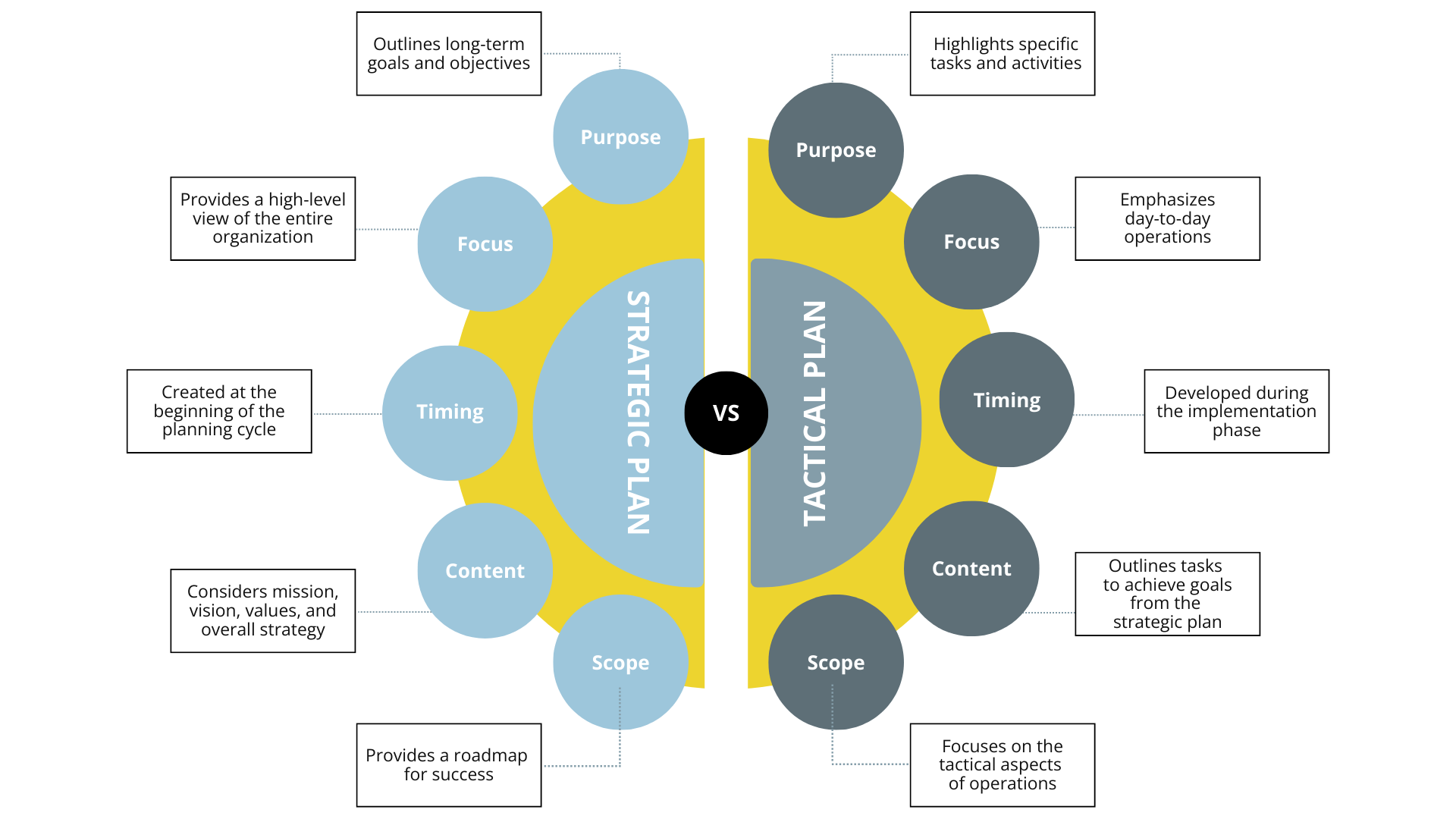
Important Insight about Strategic Planning:
The typical strategic planning process employed by many consultants in the nonprofit sector results in an aesthetically pleasing PDF document that is presented to the board and potential donors. However, most do not include a Tactical Plan that encompasses change management strategies and well-defined Key Performance Indicators (KPIs). Having a strategic plan alone is insufficient; it must be complemented by a tactical plan featuring clear timelines and measurable benchmarks. When engaging a consultant to lead your nonprofit’s strategic planning process, it is crucial to request examples of tactical plans they have previously assisted in creating.
At Catapult, we emphasize the creation of winning strategies over mere strategic plans. We believe it is not enough for a plan to merely look impressive on paper; there must be a seamless integration between a visually appealing Strategic Plan that gives a roadmap for success and a well-executed Tactical Plan that ensures success.
To assist nonprofit organizations in this endeavor, below are three templates that have proven valuable for many.
As every nonprofit organization is unique, with its distinct opportunities, challenges, mission, and DNA, each strategic plan is inherently distinctive. The purpose here is to provide you with 3 template models on how to approach your planning process before delving into the specifics. A visual of each strategic planning model that incorporates both Design and Accountability in included, recognizing that both elements are essential for effectively implementing your strategic plan.
After all, what good is a winning strategy on paper if there is no effective mechanism to bring it to life?
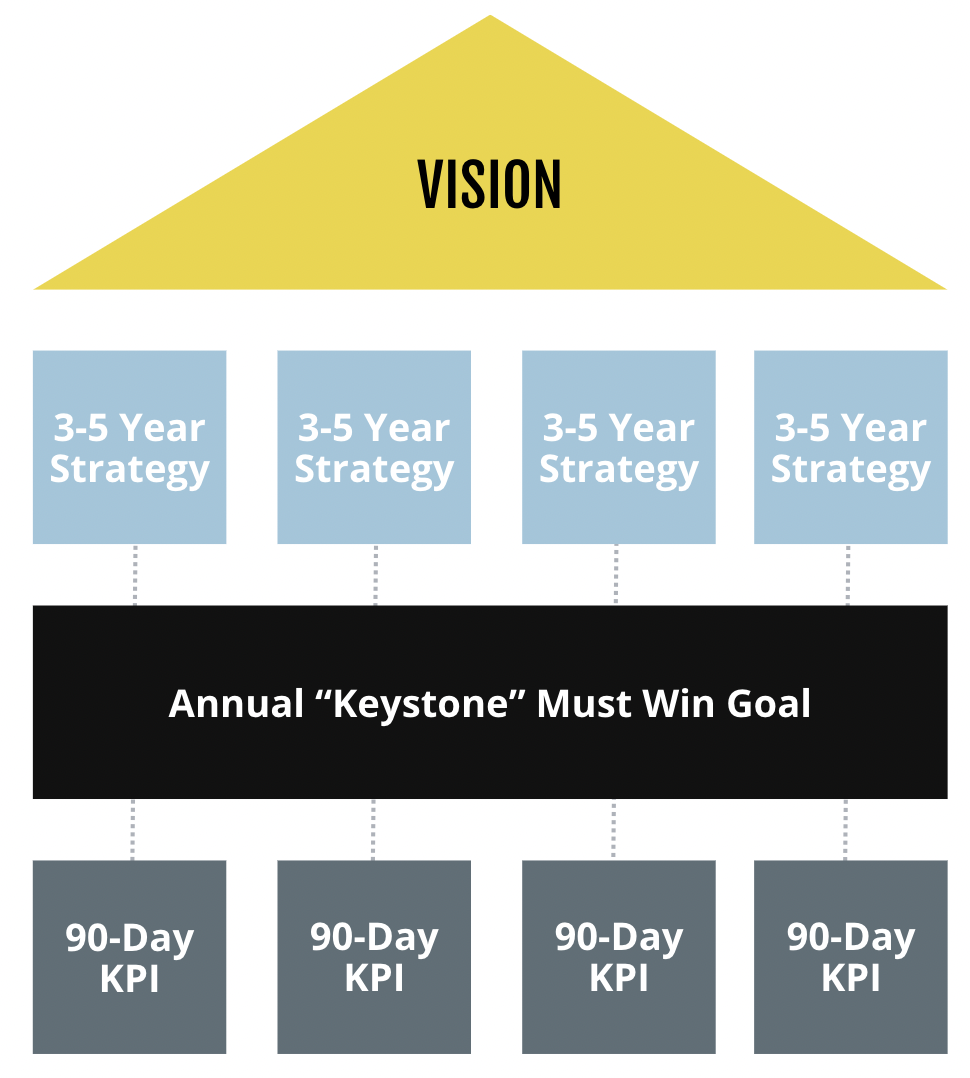
This Strategic Planning Template integrates a vision-driven approach with clear, intentional progression. It begins with the Vision, guiding the organization’s strategic layers. From there, leaders define high-level 3-5 Year Strategies and an Annual “Keystone” Must Win Goal, acting as a catalyst for organizational progress. To ensure accountability and progress, Weekly Check-ins and Monthly Reviews against KPIs and Annual Objectives keep everyone on track. The Quarterly Refresh fine-tunes the strategy in real time, while Annual Reviews provide a crucial decision point for completing or rolling over Annual Objectives. This model combines vision with practicality, creating a dynamic roadmap for a nonprofit’s success. Finally, nonprofit leads are not left to choose between a Strategic Plan or a Tactical Plan that activates your strategy into day-to-day workflow. This comprehensive planning process includes both.
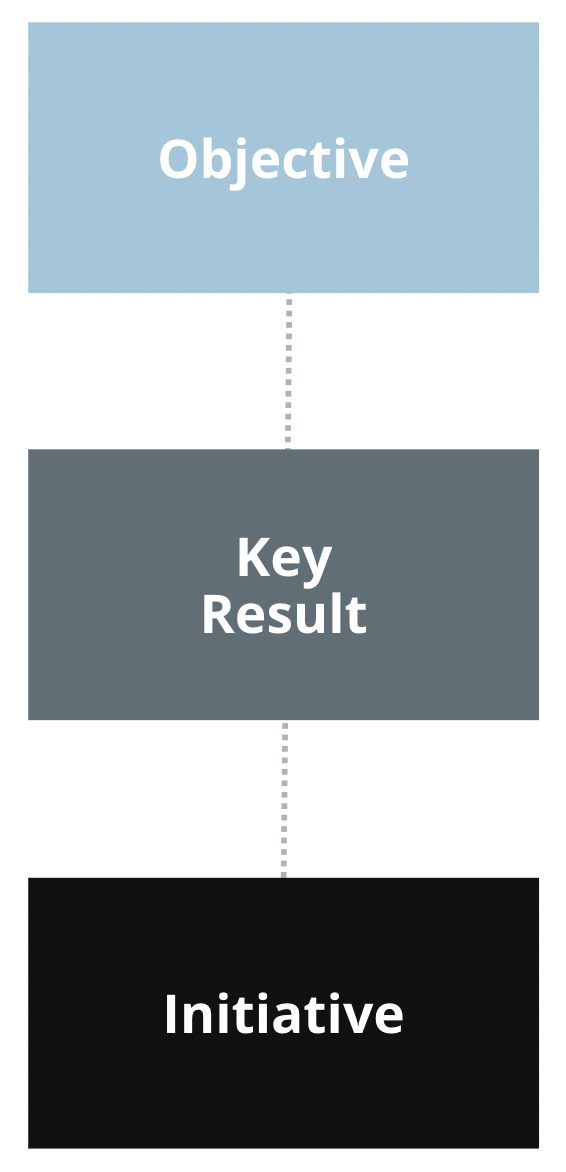
The OKR (Objectives and Key Results) model, as discussed in the points above, is a structured approach to goal-setting and performance measurement. The key to the process is stringent Weekly Check-ins and reviews, which introduces a level of administrative overhead for individuals and teams. One potential downside in the model is the Quarterly Refresh can lead to frequent changes in objectives, potentially disrupting ongoing day-to-day work. Finally, the Annual Reviews require thorough assessment and decision-making regarding the continuation or adjustment of objectives, adding a formalized process to the annual planning cycle.
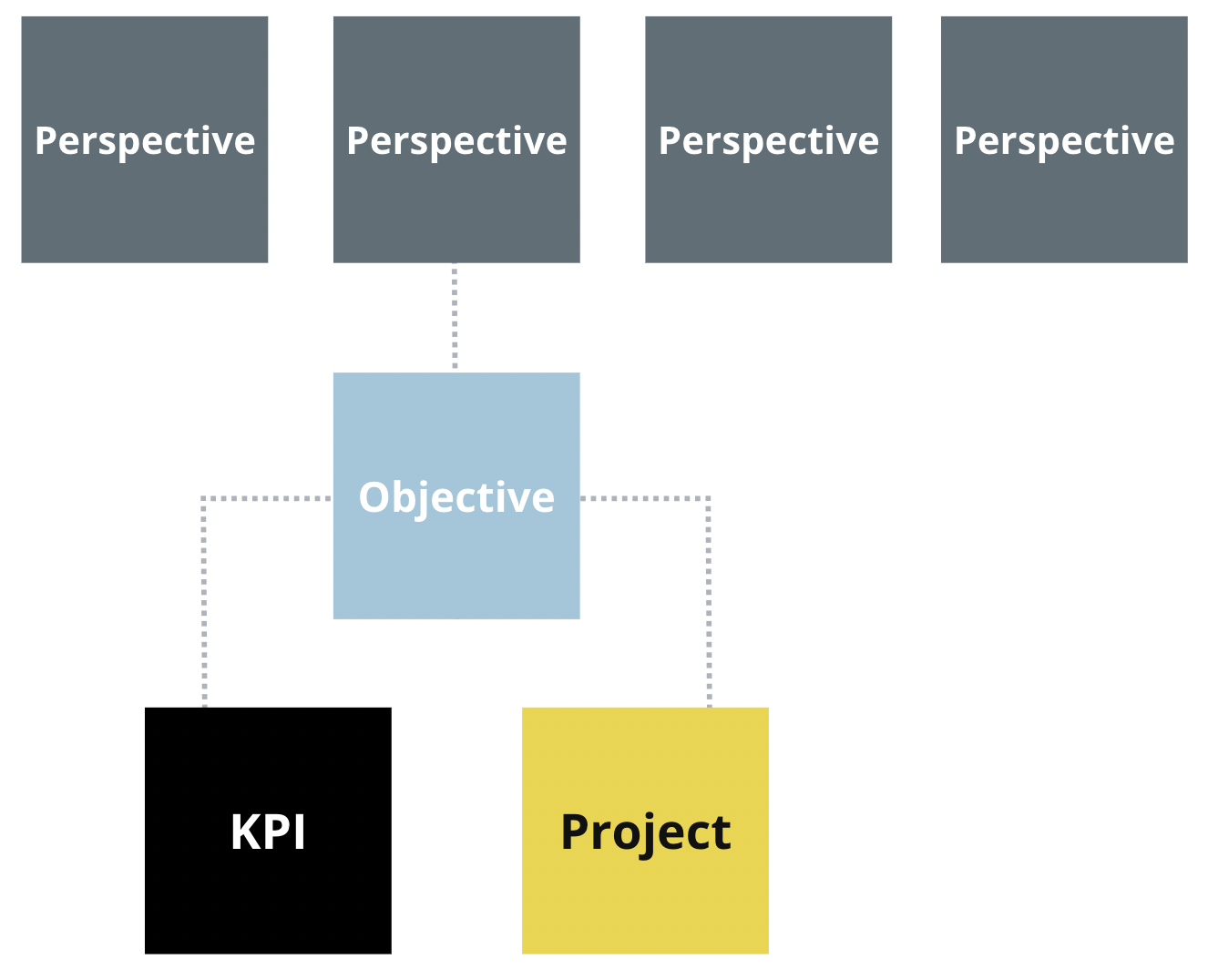
If you’re feeling overwhelmed by the idea of starting a strategic planning process with the nonprofit you help lead, we get it! It’s an important time in the life of any nonprofit and it can be a difficult journey. We would love to help you find a guide for that process. Whether that is Catapult helping you lead this journey or pointing you to a better fit, we would love to serve you.
Catapult’s published The Ultimate Strategic Planning Black Book to help nonprofits like yours take the first steps towards developing a rock-solid strategic plan. Join our email list to get the guide now.

The page you requested could not be found. Try refining your search, or use the navigation above to locate the post.